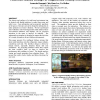Free Online Productivity Tools
i2Speak
i2Symbol
i2OCR
iTex2Img
iWeb2Print
iWeb2Shot
i2Type
iPdf2Split
iPdf2Merge
i2Bopomofo
i2Arabic
i2Style
i2Image
i2PDF
iLatex2Rtf
Sci2ools
CHI
2005
ACM
2005
ACM
Attention-based design of augmented reality interfaces
The objects and surfaces of a task-based environment can be layered with digital interfaces to make them easier and safer to use. Once information can be projected anywhere in the space, it becomes crucial to design the information to make optimal use of users' attention. We have prototyped and evaluated a real-world augmented reality kitchen where user-centered interfaces and displays can be projected anywhere in the space to improve its usability. The augmented environment is designed to support the activities of a variety of people in diverse kitchen environments. This paper presents five intelligent kitchen systems that layer useful interfaces onto the refrigerator, range, cabinets, countertops and sink. The interface design is driven by human factors, especially attention theory and user evaluations. By projecting interfaces where they require the least cognitive load, we hope to improve the performance and confidence of users. The design employs cueing and search principles...
Augmented Reality Kitchen | CHI 2005 | Human Computer Interaction | Information Interfaces | User-centered Interfaces |
| Added | 30 Nov 2009 |
| Updated | 30 Nov 2009 |
| Type | Conference |
| Year | 2005 |
| Where | CHI |
| Authors | Leonardo Bonanni, Chia-Hsun Lee, Ted Selker |
Comments (0)

